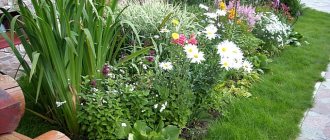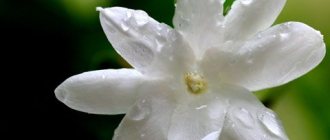White flowers have a special charm, so they are actively used by gardeners to form beautiful and original compositions. But it’s not just the combination of such flowers with other varieties that looks very interesting, but a full-fledged white flower garden made from the appropriate plantings. The advantage of this solution lies not only in its aesthetic appearance, but also in the ability to visually expand the space, which is important for small areas. In this article we propose to consider stunning compositions of white flowers that can be actively used in your area.
Features of the formation of flower beds of white flowers
To create a white flower garden of perennials that will look the same in both spring and autumn, you should choose the flowers correctly and harmoniously. The variety of garden flora with white colors is not so great as to fill them with flowering throughout the summer season.
It is worth taking care of the presence of green spaces with variegated leaves that will fill the voids between flowering. Also, when forming such flower beds, it is worth considering other points:
- plants should be maintained in perfect condition;
- When laying out a flower bed, avoid flat-shaped reliefs; keep in mind that the flower bed should be interesting both horizontally and vertically; it would be better to combine lush plants with tall ones to create harmonious compositions;
- take into account the contrast in the height of the crop, the size of the inflorescences and flowers, combine large and small forms.
Also remember that if there is furniture or decorative elements on the site, they should be in pastel shades so as not to stand out from the overall composition, not to be flashy, and not to spoil the overall appearance.
If you have absolutely no idea what a white flowerbed should look like, then it’s better to look at several options on the Internet and get inspired by ideas in photographs. You can try to start creating a white garden in miniature volumes, and only then move on to experiments with larger sizes.
How to propagate monstera?
Indoor liana reproduces in three ways:
- by air layering - this is the easiest way of propagation; layering with at least one leaf plate and an aerial root is suitable for it; they are lowered into the ground to form an independent plant; they can be temporarily placed in plastic bottles to form roots;
- by cuttings - the use of lateral and stem shoots as material is practiced, the cuttings are rooted in pots under a glass greenhouse; before roots appear, the glass is lifted, ventilated and watered twice a day, and then transplanted into a larger pot;
- seed method - pots with sown seeds must always be kept warm and receive sufficient light. The first shoots appear after about 30 days. By the age of two years, an average of 9 leaves can be counted on a plant.
How does it bloom?
The flowering of vines with large white flowers occurs mainly in the natural environment; the flowers look like the sails of a yacht or the cap of a small gnome. Corn-cob-like fruits then appear, which turn purple when fully ripe. In the delicious monstera, these fruits are suitable for consumption.
The monstera plant blooms, extremely rarely, flowers appear in greenhouses and winter gardens. When grown at home, it is almost impossible to observe exotic flowering.
Original flowerbed of white flowers for partial shade
White perennials for semi-shaded areas should be carefully selected. It is important that the plants thrive in such conditions. An excellent option would be to use the tree-like Hydrangea “Annabelle”, which is covered with lush flowers. Its beauty can be enjoyed until September, only then the white color of the buds will change to green.
Hydrangea variety Anabel looks impressive when planted alone.
You can also plant the tree-like White Dome Hydrangea. It has openwork flat inflorescences. The paniculate Hydrangea "Kyushu" looks beautiful. It is distinguished by openwork loose panicles; it blooms from July to September. White beauties of the White Lady and Limelight varieties would also be appropriate in such a flower bed. The petals of these flowers resemble Carnations, which looks very impressive.
A contrasting solution to Hortense will be the landing of Chubushnik. These shrubs will become the background for other crops; they are located deep in the composition itself to form the 3rd line. Decorative properties appear earlier than those of Hydrangeas, around mid-June.
Another tier will be Black Cohosh. Its flowering begins closer to August, but decorative carved leaves will decorate the flower garden until autumn. Also for the second tier use:
- Lily of the valley;
- Lupins;
- Bells.
Then Astilbes are planted, which will delight with their decorative effect even after flowering, since they have dark green dense foliage and a pleasant bronze tint.
Astilbe will decorate any garden (photo flickr.com)
Among the varieties, Weisse Gloria will look great. They are planted in large groups, 3-5 bushes, so that the decorative effect is noticeable.
What other white flowers should I use for a flower bed in partial shade?
An excellent option to complement the Chubushnik would be to plant Ferns. The proscenium can be planted with Zelenchuk, which over the course of several years will form a rich carpet of white and green shades. Violets will look beautiful and organic nearby. They grow quite quickly and are easy to care for.
The addition will be Muscari, Galanthus, and white Crocuses, which do not require annual replanting.
Advantages and disadvantages of perennials
Most summer residents prefer to choose perennials to decorate the facade and create recreation areas due to their unpretentiousness to conditions and care. Among the decorative perennial plants, you can easily choose several species that will decorate your summer cottage with white color from early spring to late autumn, give the house a well-groomed appearance, without requiring regular weeding and watering, and soil fertility.
In addition to the beautiful design of the site, some perennial flowers also bring practical benefits. Growing in a flower bed, cover perennials displace weeds from the site and help preserve the fertile soil layer.
It is believed that perennials do not have such beautiful and showy flowers as annual plants, but this opinion may also be caused by insufficient awareness of the richness and variety of ornamental flowers. Among the perennial herbaceous plants and shrubs, it is easy to find those species that delight with a variety of shapes and sizes, an intoxicating aroma, no less than annuals.
Advice! When combining annual and bulbous flowers with perennials, place the latter in a distant display, starting with low-growing plants, and then medium- and tall-growing flowers, so that they do not cover each other.
But, as always, there are no advantages without disadvantages. Very often, perennial flowers and shrubs tend to grow, occupying an increasing area of the flowerbed or plot every year. This happens precisely because of their low maintenance requirements. If you really like, for example, lilies of the valley, then do not forget to limit the space for them with high ridges and flowerpots so that next season they do not occupy the territory intended for other flowers. The same rule applies to other perennials that have a powerful root system.
Creating a drought-resistant white flower garden in the sun
Sunny areas require resistant plants that love ultraviolet rays and can withstand fairly high temperatures. The frame of such a flower bed can be Spirea and Lilac, reaching a height of up to 2 meters. Full flowering can only be achieved if there is a sufficiently large amount of sunlight. It is also worth planting several varieties of white English Roses. It’s just better to choose one variety, for example, David Austin “Claire Rose”. For those who do not understand how to care for Roses, Kuril tea (Cinquefoil Bush, Cinquefoil) is suitable.
The next layer is Foxgloves (those that are two years old). Next, white Peonies will look appropriate. They look decorative even after flowering. Carved leaves will serve as a background for the Phloxes.
Companions to these flowers will be Yarrow or Pearl Oyster. Next it is worth placing Arabis, which will be perfectly complemented by small white flowers for the flower bed - Tulips, Hyacinths and Daffodils. At the end of their flowering, white annual flowers should be placed - Tobacco, Lavatera, Petunia, Levkoi. You can also mention the herbaceous crop Canary. This plant reaches a height of up to 1.2 meters. It has narrow leaves with veins in light colors. It is because of this that it often serves as a monochrome plant.
The “voids” between these crops can be filled with white Lilies of only one variety. They will make the formed flower garden complete.
How to properly care for monstera?
When bringing such beauty into your home, you need to consider that this tropical plant grows large even indoors. This means that as you grow, it will take up more and more of your space, and the rise in height is stopped only by the ceiling level. Then it becomes more difficult to care for the upper leaves.
Monstera care at home
air layering monstera
Monstera is distinguished by its high ability to develop aerial roots that extend from the trunk of the plant. The plant throws out quite a lot of them, and these roots grow to a great length. They are designed to secure the plant to support points or in the soil.
Long ago, tropical forest pioneers mistook the monstera's aerial roots for the long tentacles of an unknown monster. But in truth, these shoots are very fragile and are of great importance for the life of the vine ; rough handling of them should be avoided and any damage should be avoided. If the wall near the monstera is rough or textured, the roots may become firmly attached to it. If these adventitious roots are long enough, they should be directed to the pot for rooting.
A liana, especially a large and heavy one, cannot do without support; for this, special supports decorated with coconut fibers are usually purchased. For growing plants, a smaller support is also suitable.
Suitable lighting and temperature levels
In its natural environment, monstera grows in shady but sufficiently lit areas.
After all, direct sunlight leaves burns on the leaves, and the lack of light slows down the growth of the beauty, up to a complete stop. This, of course, will not lead to death, but the appearance of the plant will deteriorate and the decorative effect will decrease. The temperature comfortable for the successful development of monstera ranges from 10 to 24 degrees above zero. The plant is resistant to sudden temperature changes. The warmer the air, the faster the monster grows, provided there is sufficient humidity.
In a cold room, the plant stops developing and goes into a dormant state until the air temperature becomes comfortable.
Watering and fertilizing regime
Monstera comes from the tropics, which means it loves high humidity. It is necessary to periodically moisten the leaves of the plant, because they constantly saturate the room with moisture. Therefore, the leaves of the vine are wiped with a damp cloth, and for a glossy shine, water and milk are mixed.
An actively growing plant needs light watering; do not allow the substrate to become dry. When entering a dormant state, minimal watering is recommended.
For good growth and maintaining high decorative properties, the monstera is fed in a timely manner using fertilizers with organic and mineral substances. In the summer, fertilizers are applied weekly, with the onset of cold weather - 1-2 times a month.
How to replant?
Monstera has a high growth rate, so the growing vine must be replanted annually, sometimes every two years.
When replanting, it is better to exercise extreme caution, because the vine is very delicate, plus you should remember about the fragile aerial roots. Upon reaching 5-6 years of age, the plant acquires enormous dimensions, which means that replanting should be stopped. From now on, you can limit yourself to regular replacement of the top layers of the substrate.
An adult plant requires a wide and deep pot, because the root system of the plant is very powerful and voluminous. In a cramped pot, the monstera slowly dies.
Good drainage is placed in the lower third of the pot, the remaining volume is filled with a mixture of the following components:
- peat 1 share
- turf 1 share
- humus 1 share
- sand1 share
As you understand, everything is taken in equal proportions and mixed. Or buy a special substrate in the store.
Is pruning necessary?
Monstera is pruned once at a young age to begin the formation of a voluminous spreading plant. Repeated and final pruning can be done for more branching.
It must be taken into account that the pruned vine is suitable for growing only in large rooms, and it needs good and strong support.
White flower garden in shady areas
If your garden is located in complete shade, this is not a reason to abandon the idea of a white flower garden.
Photo of a flower garden with shade-tolerant flower crops
Ideal for such compositions:
- Astilbe. Beautiful varieties are Brautschleier and Bridal Veil. They are distinguished by lace flowers that look very attractive. These are perennial plants that delight with snow-white petals and beautiful openwork leaves.
- Goryanki. This is a compact perennial that will complement any flower bed. It looks extremely delicate, forms thick and dense bushes. The white Niveum variety is charming, reaching a height of up to 25 centimeters. Flowers are often compared to fairies or elves, so the plant is worth attention.
- Bought. The most popular variety is Solomon Seal. It reaches a height of up to 60-90 centimeters. The leaves have a linear or elliptical shape. The flowers are bell-shaped and look like droplets or pearls.
- Tiarella. The culture forms dense bushes that have incredibly delicate leaves. The plant reaches a height of up to 30 centimeters. The flowers create an attractive lace effect, they are shaped like stars and bloom with the arrival of May.
- Hosts. This is an ideal choice for shady areas. It is distinguished by a bright white border on green leaves. The flowering is also very beautiful, the peduncle reaches a height of up to 30 centimeters.
Based on these plants, you can form beautiful white flower beds
White garden and landscape design styles
A monochrome garden in shades of white will suit any style. You just need to choose the right plants and place accents.
Classic design
Classic presupposes clear boundaries. As a rule, conifers and evergreens predominate in such gardens. The strict lines of borders and green trimmed walls made of boxwood or thuja are complemented by white roses or hydrangeas. Paths sprinkled with white pebbles or marble chips complete the look.
Country style
To create a monochrome white garden in a “rustic” style, fragrant phlox, mallow, and iberis are suitable. A snow-white scattering of modest daisies, asters and daffodils.
Romantic garden
If you decide to decorate the area in a romantic style, then use snow-white clematis and climbing roses for vertical gardening. A white bench, gazebo or pergola will complement the image. And a table set for tea with a white tablecloth.
Note! White plants look great against the backdrop of trimmed or free-growing hedges.
White monochrome flower garden of tall shrubs and trees
The use of trees and shrubs is an excellent solution for forming beautiful compositions that will delight with their attractiveness for many years.
The most popular options for such a flower bed are:
- Hydrangea "Annabelle" Its height is up to 1.5 meters. Large inflorescences will delight you from July to October. The main thing is that the shrub develops in an area where there is no wind, and also receives an abundant amount of water.
- Climbing Roses. One of the most sought after flowers in the garden. Arches and pergolas entwined with white roses create a stunning effect.
- Chubushnik. Up to 4 meters high. Blooms during the first half of summer. It grows well in the shade and will delight with abundant flowering in bright sunny conditions.
- Hibiscus. Up to one and a half meters high. It has petiolate leaves. The flowers are quite large. The plant does not have completely white flowers, the middle is painted red, but this makes it look no less impressive.
- Fothergill. Exotic, which reaches a height of no more than 3 meters, is distinguished by wide ovoid leaves. The flowers are very fragrant and form a spikelet.
- Derain is white. It can decorate any area with the color of its foliage. Grows well in partial shade and sun.
Before forming a flower bed, be sure to draw a diagram of what a white flower garden will look like. This will allow you to create truly original compositions that will enchant with their beauty and attractiveness.
White low-growing perennials
Probably the most popular low-growing white perennial is lily of the valley. Its gentle beauty will excite the soul of every gardener. In May, lily of the valley brings a sweet and intoxicating aroma to the garden, and the snow-white flowers emerging from under the abundant green foliage give it an unsurpassed sophistication.
In early spring, after the snow melts, snowdrops and hellebores are the first to appear in the garden. They are easy to care for and their delicate flowers attract warmth into the home. They are best planted in well-drained soil and in a bright location.
Snowdrops are replaced by crocuses. It's best to plant them in a sunny location so they will produce larger flowers and brighter green leaves. Early varieties of primroses are characterized by the fact that their leaves disappear after flowering, allowing the rhizome to develop.
In mid-spring they are replaced by other, no less bright white perennials.
White garden perennials of low-growing species can also be represented by the following plants:
- Astrantia. A bright representative of the Umbrella family. Characteristic features are extremely beautiful flowers, visually reminiscent of cosmic stars, located on straight stems.
The shrub reaches a height of up to 90 cm. There are also species that do not reach a height of more than 15 cm. The leaves are located in basal rosettes and have a palm-oval appearance. Astrantia is a plant with a long flowering period, lasting from May to September. - Crown anemone. An elegant flower up to 45 cm high. On its vertical stem there is a large flower, similar to a poppy, richly decorated with black stamens.
Anemone easily combines with other plants in group plantings and is used to decorate alpine rockeries and flower beds. - The Spanish bellflower is a tuberous species. The maximum height of the plant is about 50 cm. Its small, bell-shaped flowers are arranged in clusters.
The long, lush leaves disappear a month after flowering, allowing tubers to develop. The flowering period is from April to May. These white perennials are best planted in semi-shaded areas in fertilized soil. - Evergreen Iberia. Strong, branched stems about 40 cm high.
During the flowering period, the plant is abundantly covered with snow-white flowers (up to 5 cm in diameter). It is best to plant in nutritious, well-moistened soil in a well-lit area of the garden. - White perennial bell-shaped flower. A herbaceous plant belonging to the bellflower family. The shape of the flower resembles a miniature bell.
The inflorescence has the shape of a cyst or panicle with small snow-white flowers. Grows best in sunny locations in well-drained soil. It cannot tolerate excess soil moisture, gets sick and dies. The maximum height of the bush reaches 30-35 cm. It can bloom almost all summer. - Trillium. A white garden perennial with graceful flowers with six pointed petals. The leaves are round with a pointed apex. Blooms in April and May.
Prefers a shady, semi-shaded location and well-drained substrate. Trillium thrives among large coniferous trees and is an indispensable companion to coniferous alleys and other plantings.











